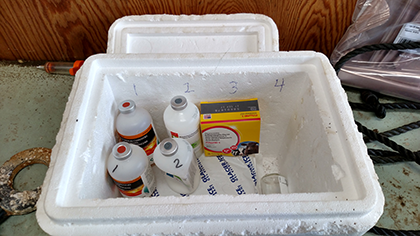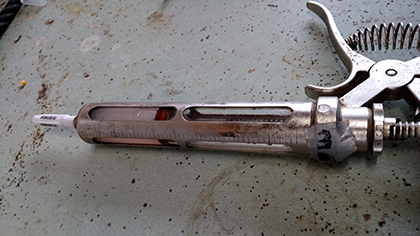BROOKINGS, S.D. – A good vaccination program is only as good as the techniques used in each step of administration, said Taylor Grussing, SDSU Extension Cow/Calf Field Specialist.
“Seventy percent of beef operations administer vaccines to cows and calves at least one time every 12 months,” said Grussing. “With many dollars being invested in vaccines and herd health each year, it’s important to make sure the vaccines are taken care of, as well as administered correctly for livestock wellbeing and to help producers get the most bang for their buck.”
Chute Side Tips
Below, Grussing outlines some tips to simplify the process and help producers stay organized during fall processing.
1. Start with clean equipment – draw up boiling or hot water into the syringe barrel and dry as much as possible. Periodically, syringes can be taken apart and boiled for a more thorough cleaning; however, some plastic or nylon syringes may not hold up to this process. Do not use chemical sterilants.
2. Keep vaccines cool and out of direct sunlight – Sunlight and UV light will inactivate vaccines so keeping vaccines and syringes in a cooler with ice packs while processing is critical during warm temperatures.
Low cost vaccine coolers can be made with a plastic bucket and lid or Styrofoam cooler by cutting holes in the lid or side. More elaborate vaccine coolers can be made with plastic coolers, pvc pipe and a drill.
Oklahoma Cooperative Extension Service provides instructions for making a Chute Side Vaccine Cooler here.
3. Label Everything – label all vaccines to corresponding syringes with duct tape or different colored knobs and markers.
In addition, label the place in the vaccine cooler where they should be stored after every use to prevent mistakes. A simple 1, 2, 3 system can be utilized to alleviate any need to remember exact names of products.
4. Mix for 30 minutes – When mixing modified-live virus (MLV) vaccines, do not mix more vaccine solution than can be injected within 30 minutes.
Since MLV should be used right away and cannot be stored for future use, if an unexpected interruption occurs – chute breaks or cattle numbers do not match up with the amount of vaccine that is available – producers don’t want to be stuck throwing out unused mixture.
Use a clean transfer needle to mix products and draw up new doses into the syringe with a brand-new needle every time to prevent contamination.
5. Check label for dosage and route of administration – To avoid giving the wrong dose of a vaccine or using the wrong administration method, take a few minutes to re-read vaccine labels and set syringes to the correct dosage before starting.
Also, determine the correct method of administration (subcutaneous or intramuscular) and put the correct size and length of needed on the appropriate syringe.
6. Clean and inspect – clean everything up and inspect all equipment before properly storing.
“These simple steps can help maximize efficiency when working cattle, while also improving efficacy of health programs leading to more profitable cattle on the operation,” Grussing said. “Once everything is in order, processing cattle is much more enjoyable for everyone involved.”
She also encouraged producers to utilize beef quality assurance best management practices by giving vaccinations in front of the shoulder in the neck region.
“Proper injection sites are not only are safer for the animal and handler but also the meat quality and wholesomeness,” Grussing said.
Courtesy of iGrow. A good vaccination program is only as good as the techniques used in each step of administration, said Taylor Grussing, SDSU Extension Cow/Calf Field Specialist. One tip Grussing shares is to label all vaccines to corresponding syringes. Figure 1. Labeled cooler and vaccines ready for anyone who is loading syringes.
Courtesy of iGrow. A good vaccination program is only as good as the techniques used in each step of administration, said Taylor Grussing, SDSU Extension Cow/Calf Field Specialist. One tip Grussing shares is to label all vaccines to corresponding syringes.
Source: SDSU iGrow





Leave A Comment